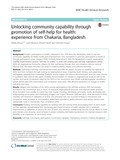Unlocking community capability through promotion of self-help for health: experience from Chakaria, Bangladesh
| dc.contributor.author | Bhuiya, Abbas | |
| dc.contributor.author | Hanifi, Syed Manzoor Ahmed | |
| dc.contributor.author | Hoque, Shahidul | |
| dc.coverage.spatial | Bangladesh | en |
| dc.date.accessioned | 2017-04-20T11:55:13Z | |
| dc.date.available | 2017-04-20T11:55:13Z | |
| dc.date.issued | 2016-11-15 | |
| dc.identifier.citation | Bhuiya, A., Hanifi, S.M.A. and Hoque, S. (2016) Unlocking community capability through promotion of self-help for health: experience from Chakaria, Bangladesh. BMC Health Services Research, 16(7): 624.. | en |
| dc.identifier.issn | 1472-6963 | |
| dc.identifier.uri | https://opendocs.ids.ac.uk/opendocs/handle/20.500.12413/12951 | |
| dc.description.abstract | Background People’s participation in health, enshrined in the 1978 Alma Ata declaration, seeks to tap into community capability for better health and empowerment. One mechanism to promote participation in health is through participatory action research (PAR) methods. Beginning in 1994, the Bangladeshi research organization ICDDR,B implemented a project “self-help for health,” to work with existing rural self-help organizations (SHOs). SHOs are organizations formed by villagers for their well-being through their own initiatives without external material help. This paper describes the project’s implementation, impact, and reflective learnings. Methods Following a self-help conceptual framework and PAR, the project focused on building the capacity of SHOs and their members through training on organizational issues, imparting health literacy, and supporting participatory planning and monitoring. Quarterly activity reports and process documentation were the main sources of qualitative data used for this paper, enabling documentation of changes in organizational issues, as well as the number and nature of initiatives taken by the SHOs in the intervention area. Health and demographic surveillance system (HDSS) data from intervention and comparison areas since 1999 allowed assessment of changes in health indicators over time. Results Villagers and members of the SHOs actively participated in the self-help activities. SHO functionality increased in the intervention area, in terms of improved organizational processes and planned health activities. These included most notably in convening more regular meetings, identifying community needs, developing and implementing action plans, and monitoring progress and impact. Between 1999 and 2015, while decreases in infant mortality and increases in utilization of at least one antenatal care visit occurred similarly in intervention and comparison areas, increases in immunization, skilled birth attendance, facility deliveries and sanitary latrines were substantially more in intervention than comparison areas. Conclusion Building community capability by working with pre-existing SHOs, encouraging them to place health on their agendas, strengthening their functioning and implementation of health activities led to sustained improvements in utilization of services for over 20 years. Key elements underpinning success include efforts to build and maintain trust, ensuring social inclusion in project activities, and balancing demands for material resources with flexibility to be responsive to community needs. | en |
| dc.language.iso | en | en |
| dc.publisher | BMC Health Services Research | en |
| dc.rights | This article is distributed under the terms of the Creative Commons Attribution 4.0 International License (http://creativecommons.org/licenses/by/4.0/), which permits unrestricted use, distribution, and reproduction in any medium, provided you give appropriate credit to the original author(s) and the source, provide a link to the Creative Commons license, and indicate if changes were made. The Creative Commons Public Domain Dedication waiver (http://creativecommons.org/publicdomain/zero/1.0/) applies to the data made available in this article, unless otherwise stated | en |
| dc.rights.uri | http://creativecommons.org/licenses/by/4.0/ | en |
| dc.subject | Health | en |
| dc.subject | Participation | en |
| dc.title | Unlocking community capability through promotion of self-help for health: experience from Chakaria, Bangladesh | en |
| dc.type | Article | en |
| dc.rights.holder | © The Author(s). | en |
| dc.identifier.externaluri | https://bmchealthservres.biomedcentral.com/articles/10.1186/s12913-016-1865-9 | en |
| dc.identifier.doi | 10.1186/s12913-016-1865-9 | |
| dcterms.dateAccepted | 2016-11-15 | |
| rioxxterms.funder | Default funder | en |
| rioxxterms.identifier.project | Default project | en |
| rioxxterms.version | VoR | en |
| rioxxterms.versionofrecord | 10.1186/s12913-016-1865-9 | en |
| rioxxterms.funder.project | c941507f-fd0b-4fc3-9822-4b2132f61a1d | en |
Files in this item
This item appears in the following Collection(s)
Except where otherwise noted, this item's license is described as This article is distributed under the terms of the Creative Commons Attribution 4.0
International License (http://creativecommons.org/licenses/by/4.0/), which permits unrestricted use, distribution, and
reproduction in any medium, provided you give appropriate credit to the original author(s) and the source, provide a link to
the Creative Commons license, and indicate if changes were made. The Creative Commons Public Domain Dedication waiver
(http://creativecommons.org/publicdomain/zero/1.0/) applies to the data made available in this article, unless otherwise stated


